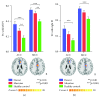Increased Insular Connectivity and Enhanced Empathic Ability Associated with Dance/Music Training
- PMID: 31198419
- PMCID: PMC6526550
- DOI: 10.1155/2019/9693109
Increased Insular Connectivity and Enhanced Empathic Ability Associated with Dance/Music Training
Abstract
Dance and music are expressive art forms. Previous behavioural studies have reported that dancers/musicians show a better sensorimotor ability and emotional representation of others. However, the neural mechanism behind this phenomenon is not completely understood. Recently, intensive researches have identified that the insula is highly enrolled in the empathic process. Thus, to expand the knowledge of insular function associated with empathy under the dance/music training background, we mapped the insular network and its associated brain regions in 21 dancers, 20 musicians, and 24 healthy controls using resting-state functional connectivity (FC) analysis. Whole brain voxel-based analysis was performed using seeds from the posterior insula (PI), the ventral anterior insula (vAI), and the dorsal anterior insula (dAI). The training effects of dance and music on insular subnetworks were then evaluated using one-way analysis of variance ANOVA. Increased insular FC with those seeds was found in dancers/musicians, including PI and anterior cingulated cortex (ACC), vAI and middle temporal gyrus (MTG) and middle cingulated cortex (MCC), and dAI and ACC and MTG. In addition, significant associations were found between discrepant insular FC patterns and empathy scores in dancers and musicians. These results indicated that dance/music training might enhance insular subnetwork function, which would facilitate integration of intero/exteroceptive information and result in better affective sensitivity. Those changes might finally facilitate the subjects' empathic ability.
Figures





Similar articles
-
Shared and distinct patterns of cortical morphometric inverse divergence and their association with empathy in dancers and musicians.Sci Rep. 2025 Aug 5;15(1):28572. doi: 10.1038/s41598-025-13416-2. Sci Rep. 2025. PMID: 40764652 Free PMC article.
-
Enhanced functional connectivity between insular subregions correlates with the efficacy of music and instruction-guided relaxation in depression.Neuroreport. 2020 Dec 9;31(17):1215-1224. doi: 10.1097/WNR.0000000000001534. Neuroreport. 2020. PMID: 33105441
-
The association between ballroom dance training and empathic concern: Behavioral and brain evidence.Hum Brain Mapp. 2023 Feb 1;44(2):315-326. doi: 10.1002/hbm.26042. Epub 2022 Aug 16. Hum Brain Mapp. 2023. PMID: 35972315 Free PMC article.
-
Shared and distinct functional networks for empathy and pain processing: a systematic review and meta-analysis of fMRI studies.Soc Cogn Affect Neurosci. 2020 Sep 24;15(7):709-723. doi: 10.1093/scan/nsaa090. Soc Cogn Affect Neurosci. 2020. PMID: 32608498 Free PMC article.
-
The neural basis of empathy.Annu Rev Neurosci. 2012;35:1-23. doi: 10.1146/annurev-neuro-062111-150536. Annu Rev Neurosci. 2012. PMID: 22715878 Review.
Cited by
-
Musicians' pursuit of expertise-related goals is characterised by strategic regulation of functional and counterproductive affect.Front Psychol. 2024 Sep 4;15:1407303. doi: 10.3389/fpsyg.2024.1407303. eCollection 2024. Front Psychol. 2024. PMID: 39295770 Free PMC article.
-
Inner sense of rhythm: percussionist brain activity during rhythmic encoding and synchronization.Front Neurosci. 2024 Feb 14;18:1342326. doi: 10.3389/fnins.2024.1342326. eCollection 2024. Front Neurosci. 2024. PMID: 38419665 Free PMC article.
-
Musical Expertise Shapes Functional and Structural Brain Networks Independent of Absolute Pitch Ability.J Neurosci. 2021 Mar 17;41(11):2496-2511. doi: 10.1523/JNEUROSCI.1985-20.2020. Epub 2021 Jan 25. J Neurosci. 2021. PMID: 33495199 Free PMC article.
-
Musical Training in the Development of Empathy and Prosocial Behaviors.Front Psychol. 2021 May 11;12:661769. doi: 10.3389/fpsyg.2021.661769. eCollection 2021. Front Psychol. 2021. PMID: 34045996 Free PMC article. Review.
-
Trait representation of embodied cognition in dancers pivoting on the extended mirror neuron system: a resting-state fMRI study.Front Hum Neurosci. 2023 Jul 10;17:1173993. doi: 10.3389/fnhum.2023.1173993. eCollection 2023. Front Hum Neurosci. 2023. PMID: 37492559 Free PMC article.
References
Publication types
MeSH terms
LinkOut - more resources
Full Text Sources
Research Materials
Miscellaneous

